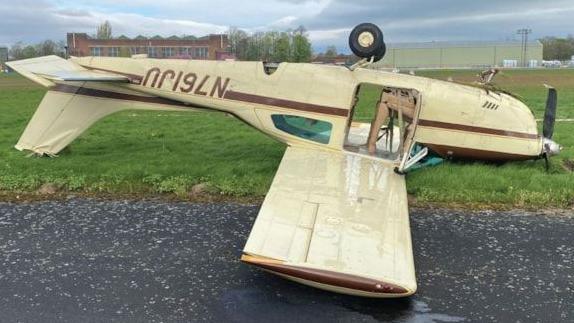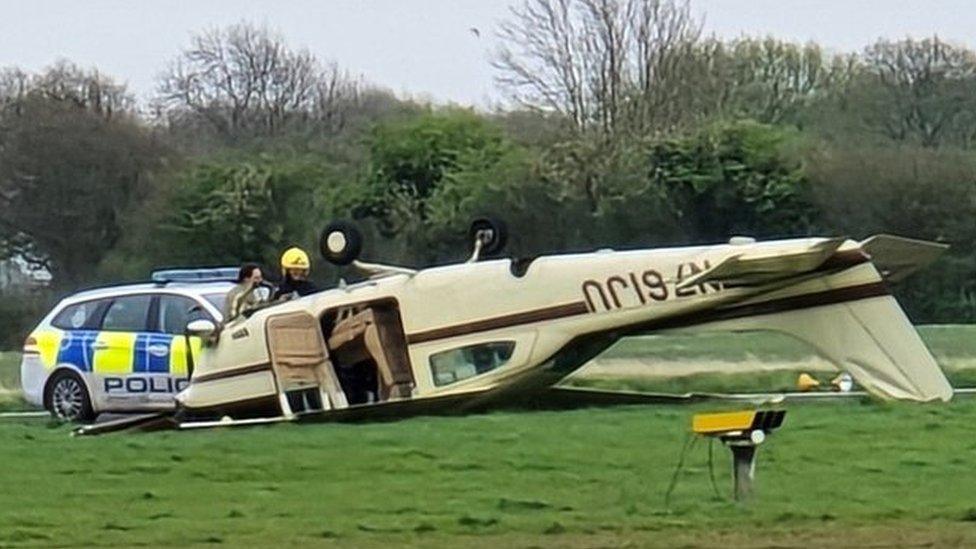Autopilot fault blamed for fatal crash - report

The passenger of the plane died several days after the crash in April last year
- Published
The crash of a light aircraft after it was unable to take off from an airfield, leading to the death of a passenger, was most likely due to an "intermittent fault" with its autopilot, an investigation has found.
The passenger, a man in his 70s, was critically hurt when the Cessna crashed at Leeds East Airport on 11 April 2024 and died eight days later, a report by the Air Accidents Investigations Branch (AAIB) said.
The reported stated the pilot, 79, who was less "securely restrained" than his passenger, escaped with minor head and back injuries.
In its report, the AAIB recommended the Civil Aviation Authority publish guidance and best practice for general aviation pilots on autopilot systems.
According to the findings of the AAIB's investigation, the "intermittent fault" with the Cessna T210M's autopilot system, unknown to the pilot, had meant the aircraft's elevator trim position could change from "Take Off" to "Nose Down".
This would have made it extremely difficult for him to balance competing aerodynamic forces when trying to take off at the airfield, formerly RAF Church Fenton, near Tadcaster, North Yorkshire, an AAIB spokesperson said.
Despite the pilot's attempts to bring the plane to a halt on the runway after realising there was a problem, the plane briefly took off before it then "descended rapidly, landing heavily on the nosewheel".
"Eyewitnesses reported seeing the aircraft touch down and bounce two or three times before, on the last bounce, the nosewheel detached," the report said.
After landing, the plane left the runway and came to a stop upside down after the remains of its nose landing system had dug into soft ground.
'Unsurvivable injuries'
The AAIB investigation report said the pilot had secured his lap belt for take off, but left the shoulder strap unfastened, while his passenger was wearing both belts.
"The passenger sustained unsurvivable injuries despite having all his seat harness straps secured," it stated.
"Given the passenger was unresponsive after the aircraft came to rest, he was likely rendered unconscious by his head striking the cabin roof as the aircraft came to rest [upside down]."
The report said the passenger - who was described as an "experienced private pilot" and "a close friend for many years" of the pilot - would likely have suffered a more severe head impact than the pilot as the aircraft landed on its roof.
The AAIB investigation could not determine why the autopilot mode was engaged at take off.
Pilots of light aircraft took off and landed their planes manually - and ensuring the autopilot mode was switched off before take off was part of pre-flight checks, the AAIB spokesperson said.
In its report, the AAIB said it had "recommended that the Civil Aviation Authority publish guidance and best practice on the use of autopilots in general aviation aircraft to improve knowledge and awareness of autopilot functionality, normal procedures, and actions to take in the event of a failure".
Get in touch
Tell us which stories we should cover in Yorkshire
Listen to highlights from North Yorkshire on BBC Sounds, catch up with the latest episode of Look North.
- Published13 April 2024
